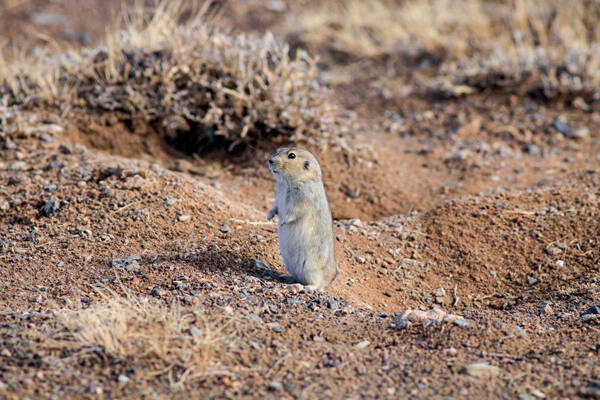Eolagurus luteus
IUCN
LCBasic Information
Scientific classification
- name:Eolagurus luteus
- Scientific Name:Eolagurus luteus,Lagurus luteus,Yellow Steppe Lemming,Yellow prairie lemming,
- Outline:Rodents
- Family:Rodentia Cricetidae Lagurus
Vital signs
- length:115-140mm
- Weight:
- lifetime:
Feature
They are large, stocky, and resemble lemmings.
Distribution and Habitat
In China, it is only distributed in northern Xinjiang. Abroad, it is distributed in Kazakhstan and Mongolia.
Unlike the steppe rabbit-tailed rat, the yellow rabbit-tailed rat is more adapted to survive in arid habitats. It mainly lives in hills and desert grasslands, and is rarely seen in meadow grasslands. After agricultural reclamation, it gathers near farmlands and canals.
Appearance
It is a relatively large species among voles, with a body length of 115-140mm and an average of about 130mm. The tail is very short, not as long as the hind legs, and the average tail length is 16mm. The average hind legs are 18mm. The fur on the back is straw yellow or smoke yellow. The fur on the ventral side is yellow. The fur is short but dense. The ears are very short and do not protrude obviously from the fur. The eyes are small, sometimes with gray patches around them. The claws are long. The skull is very thick, strong, and angular. The teeth are similar to those of other voles. These characteristics indicate that the yellow rabbit-tailed rat is a species that is more adapted to underground life and suitable for digging.
Details
The yellow rabbit-tailed rat is a typical semi-desert steppe species and is cold-resistant. It was once classified as the genus <Lagurus>. Gromov & Polyakov (1992) separated the two from the morphology, making <Eolagurus> an independent genus, but whether the independent genus status is established requires more molecular biological evidence.

The yellow rabbit-tailed rat is a diurnal rodent. In warm seasons, the time of going out of the cave is roughly consistent with the local sunrise and sunset time, but in rainy, windy and other low-temperature weather conditions, the activity is significantly reduced. The main ground activity is foraging. The feeding range is not large, mostly about 1-5 meters away from the cave entrance, and rarely 10 meters away. It moves quickly, and each feeding time is only 10-20 seconds. It bites off the stems of plants and quickly drags them back to the cave, or places them near the cave entrance, and then immediately feeds again. After feeding 10-20 times in a row, it will stay in the cave for a period of time. It does not hibernate in winter. After the habitat is covered with snow, it will dig criss-cross "snow trails" under the snow and move around in them, generally not coming out of the snow.
Yellow rabbit-tailed rats live in groups. Each burrow covers an area of about 10-100m2. In years with high numbers, the burrows are connected and the boundaries between them cannot be distinguished. There are generally 20-30 burrows, and up to 50-100 burrows. The burrows are round or oval, with a diameter of about 4-6cm. In burrows inhabited by yellow rabbit-tailed rats, their feces can be seen outside the burrows. The burrows are inclined underground at an angle of 30. -40., and the burrows are about 27-40cm from the ground. The burrows are staggered, and the total length of each burrow is about 20-50m, with about 5-8 burrows. There are 1-3 nests, and the nests are padded with hay for giving birth. Some temporary shallow holes are also dug for temporary hiding to avoid natural enemies.
In summer, the yellow rabbit-tailed rat feeds on the green parts of plants. It is not shy about eating all kinds of grass in its habitat, and even eats Salsola and Camelgrass in wasteland. It also eats seeds in autumn. The yellow rabbit-tailed rat has not been seen to hibernate in winter, and it forages under the snow in winter.
The yellow rabbit-tailed rat begins to breed in mid-April and ends in mid-September. It produces 3-4 litters a year, with a gestation period of about 20 days. Each litter has an average of 7 (3-12) pups. The first litter of pups born that year reaches sexual maturity in autumn and can participate in breeding.

The number of yellow rabbit-tailed rats fluctuates dramatically. When a large outbreak occurs, the grassland vegetation is severely damaged, and the grass production of the pasture can be reduced by 30%-40%. The holes they dig are all over the grassland, and the lower layer of raw soil is piled up on the surface, covering the original vegetation, causing the surface to be exposed. Yellow rabbit-tailed rats not only eat up all the edible plants around the hole, but also migrate to other places to find food. Therefore, they often bring catastrophic losses to the pasture. At the junction of agriculture and animal husbandry, they will also steal alfalfa, rice seedlings and melon vines in groups. Rabbit-tailed rats are also the carriers of erysipelas, tularemia and plague.
Listed in the 2008 IUCN Red List of Threatened Species ver 3.1 - Least Concern (LC).








